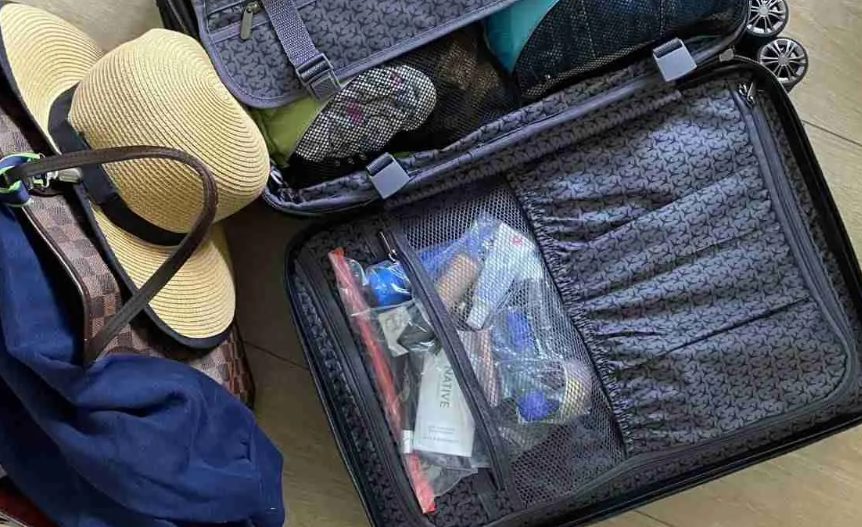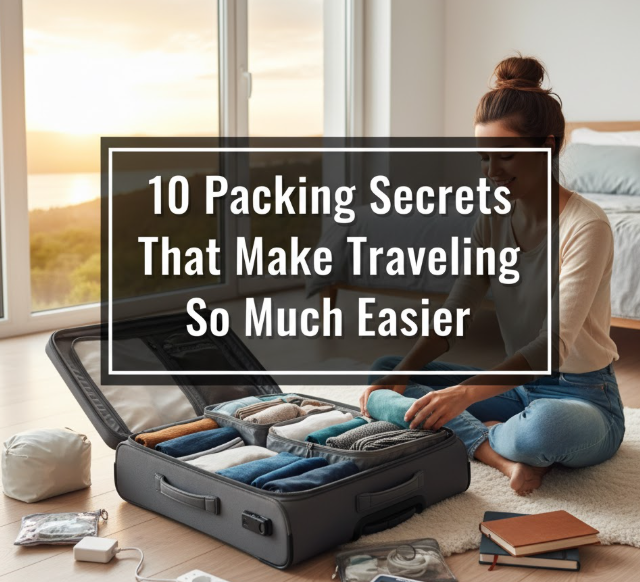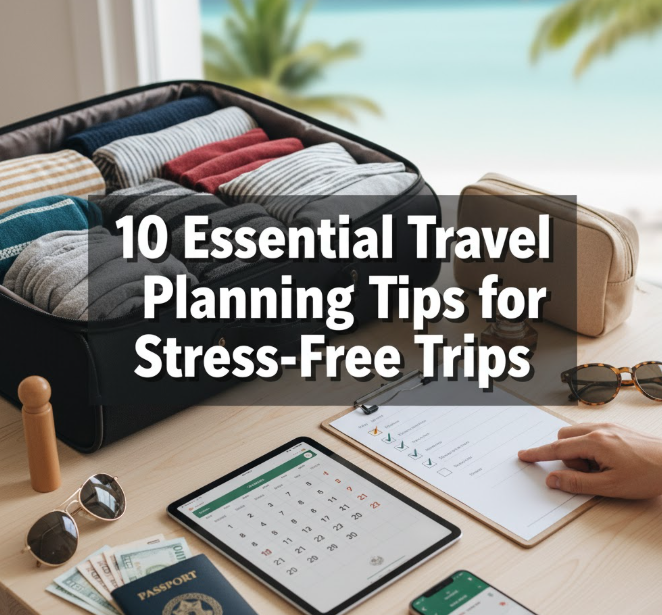Imagine this: You’re at the airport counter, sweating as you attempt to squeeze yet one more thing into your stuffed suitcase and those in line behind you impatiently exhale. We’ve all been there, right? And the reality is, packing doesn’t have to be something that triggers a panic attack and has you in your suitcase all night shoving things inside. Whether you’re heading out for a weekend retreat or traveling the world for a month, learning the best packing hacks can literally change your travel life.
Four years and many stuffed, wrinkled garments later (seriously — so wrinkled) I’ve accumulated the most effective packing hacks that are truly worth following. And not the kind of meaningless tips you’d promptly forget, either – these are real life solutions that’ll stop wasting your time, money and sanity. So, now that you’ve packed for grown-ups to a science, let’s review the secrets that will transform you from a person who packs with roughly organized chaos into someone who is TSA-precheck-level prepared.
Secret #1: Bundle Wrapping All the Way (Don’t Roll Again)!
You may have heard about rolling your clothes, and it’s all right, but there’s an even better way to fold clothing for travel called bundle wrapping. This technique not only keeps your clothes super wrinkle-free, but it also takes up less space than you’d think.
Here’s how it works: Begin with a core item (a small pouch, a toiletry bag), and lay it down the middle of your suitcase. Then, fold your clothes around this core, working from the outside in and prioritizing pieces with which you’ll piece least. Jackets first, then pants, then shirts, and finally delicate items: Stick them all on top. And this garment cover wraps itself around the entire bundle, thus forming multiple layers and protecting every piece of clothes from wrinkling.
Why does this work so well? The even pressure along the surface keeps them from creating those irritating fold lines. And everything stays in place during your journey, as opposed to rolled clothes that can move and make a mess. I tried this trick on a two-week trip, and my button-down shirts were wrinkle free when I finally unpacked them at my destination.
Secret #2: Your Shoes Are Secret Storage Containers
Quit squandering all that unused space in your shoes! It is this prime real estate that most people entirely overlook. Your shoes can fit way more than you think, and if you use them wisely, they’ll leave plenty of room in your suitcase.
Use your shoes to store stuff — like socks, underwear, chargers or small accessories. You can roll up belts and coil them inside, or tuck shoes in that space full of jewelry wrapped in tiny pouches. Just be sure to nestle each shoe in a shower cap or plastic bag first – this not only avoids getting the soles of your shoes on clean clothes but also safeguards your packed gear.
And here’s a pro move: Assign one to dirty laundry as your trip goes along. Divide the left from right with a small bag, and you have a ready-made laundry system. When you return home, and just sort through everything to see the obvious dirty clothes.
Secret #3: The 5-4-3-2-1 Rule That’ll Prevent Overpacking (Like, Immediately)
The No. 1 mistake travelers make is overpacking, and that can all be traced back to fear: fear of being bored, hungry or left without any tools for a change in weather. The 5-4-3-2-1 guideline also serves as a simple formula to include everything you need for your week away.
Here’s the breakdown:
| Article Section | Amount | Examples |
|---|---|---|
| Tops | 5 | T-shirts, blouses, tank tops |
| Bottoms | 4 | Pair of jeans, shorts/skirt/leggings |
| Dresses or Outfits | 3 | Casual dresses |
| Shoes | 2 | Walking shoes + dressy/alternate pair |
| Accessories | 1 | Hat, bag, jacket, swimsuit |
This equation works because you can mix and match these pieces to create multiple outfits. 5 tops and 4 bottoms make a total of twenty possible combinations – more than enough for a week. You’ll also be doing laundry during longer trips, anyway, so packing for a week or more is pointless.
Where the real magic occurs, however, is when you select pieces that work together. Choose a color palette (such as black, white and one accent color) so everything matches up. That means that you won’t be tempted to bring along one pair of shoes simply because it doesn’t go with anything else.
Secret #4: Compression Bags Are Worth Their Weight in Gold
I’d always believed compression bags were a gimmicky travel gadget — not any more. These are, in no uncertain terms, game changers — especially when dealing with bulky items such as sweaters, jackets and winter clothes.
Travel compression bags of normal quality work by simply pushing air out through the valves. It is well known that you need to use a home vacuum cleaner for maximum compression. But guess what and here is the thing — you do not need fancy electric pumps or expensive brands like that. Cheap zip-lock style compression bags are just fine and cost a few dollars.
Fill these bags with your bulkiest stuff, seal them and then roll from the bottom (on up) to squeeze out all air. Your puffy winter jacket deflates like a pancake. This trick comes in especially handy when you’re coming back loaded down from a trip with souvenirs to spare.
One caveat: Do not compress everything. Examples of what each type works best for: Compression bags: Soft, flexible items. Don’t pack dress clothes in them if you plan to keep wrinkles at bay, and don’t squish any electronic gear or fragile pieces. And don’t forget, compressed bags don’t compress weight – only volume. For serious adventurers, be sure to check your airline’s weight limits before going too crazy!
Secret #5: Your Clothes Must Multi-Task
Each item of clothing you pack should do double duty at least. Here is how travel pros pack light for weeks, while still looking put together at every stop.
Consider that a good pair of dark jeans can go from day touring to evening dining. It pairs well with shorts when you’re out exploring, and also goes with nice pants for an evening activity. A plain black dress has as much personality in sneakers as it does with heels and jewelry.
Ask yourself whether you can wear it in at least two absolutely separate ways: If not, don’t pack it. If the answer is no, consider leaving it home. This strategy eliminates half of your packing list — and, in fact, provides you with more looks.
The more layers, the better. A light cardigan or a denim jacket can jazz up any outfit and deal with any weather shifts. Scarves are very useful as well – they make you look good, keep you warm and can act as a beach wrap or serve as emergency bags/blankets.
For more travel tips and inspiration, visit Call to Flights.

Secret #6: Pack Your Carry-On As If Your Checked Bag Will Disappear
Here’s a reality check: Airlines lose or delay about 7 bags per 1,000 passengers. That may not sound substantial, but on a full flight, multiple people will be separated from their baggage. When packing, assume your checked bag won’t arrive when you do.
Your carry-on should include:
- One outfit change (with underwear and socks) at least
- Credit cards, identification and passports should be kept in this kit along with any vital prescriptions
- Items of value, such as electronics, jewelry or costly tools
- Basic toiletries in TSA-approved sizes
- Chargers and power banks
- A small first aid kit containing a painkiller, band-aids, and whatever you might need personally
I learned this the hard way on my last trip to Iceland. They ended up sending my checked bag to Germany and for 2 days I was wearing the same clothes. So ever since then, I always packed my carry-on with the ability to live happily for at least 48 hours without my main luggage.
Here’s a nifty trick: Pack your bulkiest items on the plane. Heavy boots and an oversized jacket do not add to your luggage weight, when you’re wearing them. You can always remove them once you are on board.
Secret #7: The Plastic Bag Trick Thwarts Toiletry Tragedies
There’s nothing that can ruin a trip quicker than I unzip your suitcase and discover that shampoo has exploded all over you clothes. The change in air pressure during flight can lead to bottles leaking, no matter how tight the lid. The disaster before it happens is thwarted by the plastic bag trick.
Here’s how: The next time you’re about to seal a bottle of liquid, like shampoo or olive oil, unscrew the cap, stretch a small piece of plastic wrap over the opening and then screw the cap back on over top that layer of plastic. That creates a secondary seal designed to prevent leaks if pressure fluctuations cause the cap to come slightly loose.
Place all your toiletries into a separate ziplock bag (or even better, a waterproof toiletry bag), and then seam this pouch inside an additional plastic bag. Yes, double bagging feels excessive, but it makes a fail safe operation. And if one of those bottles leaks, it’s all contained inside the inner bag. If that doesn’t work, the outer bag gets it.
Better still — go for solid toiletries when you’re traveling. Many experience the frustration of discovering that their liquid containers have leaked on the road; shampoo bars, solid moisturizers and toothpaste tabs are leak risks eliminated altogether, don’t add to your maximum allotted number of liquids and can last through multiple trips. They’re also a whole lot greener.
Learn more about TSA liquid rules and regulations to stay prepared.
Secret #8: Photograph Everything Before You Leave
This secret doesn’t have to do with how you pack, but if anything goes wrong, it’ll save your ample headache. What to Take Photos of Before You Depart Home (And other tips for travel.)
- The contents of your bag fanned open
- Your travel documents (passport, ID, travel insurance and credit cards)
- Serial numbers on electronics, and of luggage tags
- Your stuffed bag in multiple perspectives
Email these photos to yourself or put them in cloud storage. You’ll also have proof of contents should your luggage get lost, for insurance claims. If your passport is stolen, you have the details required to obtain emergency documents. If your bag is opened by TSA and you believe anything is missing, you’ll know exactly what should be in there.
This may take you five minutes, but it could save you thousands of dollars and days of misery. I had to file one baggage claim once and it made the whole process fast and easy because I had photos of my packed items. Because I had all documentation, the insurance company approved my claim in 24 hours of receiving it.
Secret #9: The Dirty Laundry Pillowcase Trick
Here’s a genius solution that checks off two problems at once. Bring an extra pillowcase (or a big stuff sack) to use as your dirty laundry bag. Just wear as you go along and throw into your pillowcase not with the clean clothes.
Pillowcase instead of a plastic bag? It’s ventilated, so your sweaty gym clothes or wet bathing suit will never dry moldy or stinky. And you can use it as an actual pillowcase if your lodging has suspect bedding, and a makeshift bag for delicate things or beach gear.
When you’re getting ready to come home, your dirty clothes are already gathered and compacted. Just knot a pillowcase closed and toss it in your suitcase. Pillowcase and all, you can toss the whole thing in your washing machine when you get home.
For lengthier travels this set helps you stay organized on longer trips. If necessary, designate two pillowcases: one for regular dirty clothes and one for items that require special washing or hand-washing. Never again will you waste precious vacation time trying to remember which shirt got the nod already.
Secret #10: Become a Pro at Packing Order
The way you pack your suitcase matters as much as what you fill it with. Packing in the correct order prevents heavy items from crushing weaker ones and makes your bag much easier to carry.
For Checked Bags:
- Place shoes along the bottom (wheels side for rolling bags)
- Now you continue with all of the heavier items such as toiletries, electronics etc.
- Layer rolled or folded clothing
- Stuff small accessories like socks, underwear, etc. in gaps
- Then add the wrinkle-prone pieces such as a dress or suit on top
- Layer tissue paper or a dry cleaning bag over the top layer for added wrinkle protection
For Carry-Ons:
- The heavy things (laptop, books, shoes) stay in the back, right against your body when you are wearing it.
- Medium-weight clothes in the middle
- Items I access a lot (snacks, water bottle, headphones) in outside pockets
- Documents and valuables in secure but accessible places
This way of loading balances the weight effectively so as not to hurt your back and have your bag fall over. It also means you can open your suitcase at your hotel without everything tumbling out.
And one last pro tip: Pack items you might need first (pajamas and toiletries) on top or in exterior pockets. Nothing’s worse than having to unpack your full suitcase at the end of a long flight in order to brush your teeth.
Bonus Tips which Make a Difference in Reality
Although those ten secrets will revolutionize your packing, here are several additional tips that offer a big impact:
Strategically employ packing cubes: Designate one for each category (shirts, pants, underwear) so you don’t have to unpack everything in order to get dressed. Vibrant colored blocks assist you and your travel companion in keeping your stuff together.
Pack a reusable shopping bag: It packs down small but provides bonus carrying capacity for souvenirs, day trips or dirty laundry. It’s also a great place to stash your stinky shoes, far away from your clean clothes.
Download your documents: Don’t assume Wi-Fi will be available. Download PDF files of your tickets, reservations, maps and travel guides before you leave home. Take a screenshot of crucial addresses and phone numbers.
Bring an empty water bottle: Fill it after security for a way to keep hydrated without paying airport prices. At many airports, there are water bottle filling stations just for it.
You’re Only as Good As Your Pack Job for Your Next Trip
Packing doesn’t have to be the worst part of traveling. Armed with these secrets, you’ll worry less about your luggage and spend your time thinking even more about your adventure. Not only will you save on baggage fees, but also you’ll have more energy to explore (as opposed to lugging around heavy bags), and finally, you’ll actually have everything you need without bringing too much.
The best part? As a result these techniques get easier and faster each time you practice them. All of this becomes second nature after a couple of trips. You’ll be the person at the airport who breezes through security, and everyone else is wrestling with an overstuffed bag.
Begin with just two or three of these secrets on your next trip. Once you experience how much they simplify travel, you’ll inevitably incorporate other tricks into your routine. You’ll be giving THEM packing tips before you know it.
So go ahead — book that trip you’ve been fantasizing about. Now that you’ve learned how to pack like a pro, there’s one less thing standing between you and your next adventure. Happy travels!

Frequently Asked Questions
How heavy should my carry-on bag be?
Many airlines permit a carry-on up to 15-22 pounds (7-10 kg) in weight, but maximum weight differs by airline and ticket class. Budget airlines are typically stricter. To be on the safe side, a carry-on should be no heavier than 15 pounds. If you can lift it overhead with only a little huffing, you’re probably fine. And remember, a lighter bag is easier to lug through airports and fits better in overhead compartments.
Should I roll or fold my clothes when packing?
It varies by fabric and item. Roll comfortable clothes like t-shirts, denim and workout-wear — this trick is a space-saver that prevents wrinkles in all but the most delicate fabrics. Fold dress shirts, blouses or anything else that’s made of delicate fabric and tends to wrinkle. If you want to save space and minimize wrinkles, consider using the bundle wrapping technique that I detailed above. Many frequent travelers employ a mix: rolling casual items and folding or bundling nicer clothing.
Which things should not be packed in checked luggage?
Never pack valuables (jewelry, cash, electronics), important documents (passport, IDs, travel papers), medications, keys or anything you will need upon arrival. You should also avoid packing lithium batteries, e-cigarettes or anything flammable in checked bags — airlines don’t allow them. In general, if the loss of an item would devastate your trip or if it is priceless and irreplaceable, pack it in a carry-on.
How to Pack Liquids so They Don’t Leak
Try the plastic wrap: put a bit of plastic wrap over the neck of the bottle before putting the screw cap or cork back in place. Put any and all liquid in 1 gal freezer ziplock bags inside of a waterproof toiletry bag. Keep bottles upright when you can, and pad them with soft things like your clothes or towels in a surrounding nest of comfort. Switch to solid toiletries (shampoo bars, solid perfume) that can’t leak and won’t contribute to a liquid limit.
How do you pack shoes without getting your clothes dirty?
Treat each shoe as if it were a piece of clothing you will wear repeatedly and store in a shower cap, plastic shopping bag or cloth shoe bag before placing in your luggage. Shower caps are ideal because they stretch and fit them all. Place shoes around the side edges or at the bottom of your suitcase, so that they don’t directly touch your clothes. Sock chargers or small accessories in bags can fit inside the space shoes take up. If your shoes are very muddy, place them in a separate compartment or outside pocket.
How much clothing should I pack for two weeks of travel?
Take enough clothes to last approximately one week (7-8 days) and expect to wash your clothes once on the trip. That way you won’t overpack, but are always prepared. Use the 5-4-3-2-1 rule as a starting point, and add to it if necessary. Many hotels offer laundry services, or a way to hand wash items. Traveling with less makes traveling easier, and saves room for souvenirs to bring home!
Are packing cubes really necessary?
They aren’t 100 percent essential, but having them makes organizing and locating stuff a breeze. Packing cubes will compress clothes a bit, allow like to stay with like and stop your suitcase from becoming tangled up in a messy web. They are particularly useful for longer trips or if you’re sharing luggage space with a traveling companion. If you travel more than once or twice a year, they’re worth the tiny investment. Begin with a simple set of three cubes in graduated sizes.
How can I prevent my clothes from wrinkling in a suitcase?
Use the bundle wrapping method for optimal results, or consider these tips: put tissue paper or dry cleaning bags between folded layers, don’t overpack (compressed clothes wrinkle more), use crinkle-resistant fabrics whenever possible and get clothing hung up as soon as possible. Fold your dress shirts with the collar up and crossed sleeves. You can also take advantage of the inside lid of your suitcase to pack items that should remain flat and not be squished. A compact travel steamer, or wrinkle-release spray can also be a life-saver in the event you need to touch up your suit at the last minute.






